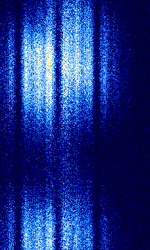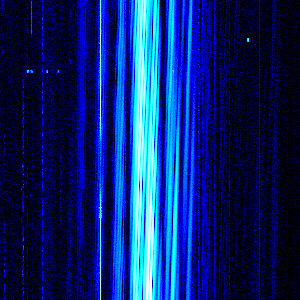SKiYMET meteor radar
| Radars | |
|---|---|
| Military: 'Ghadir' OTH Radar (Iran) - 29B6 'Kontayner' OTH Radar (Russia) - Chinese 'Foghorn' OTH radar (China) - 'OTH-SW' OTH Radar (China) - Jindalee Operational Radar Network (JORN) (Australia) - PLUTO II OTH Radar (Cyprus/UK Base) - Relocatable Over-the-Horizon Radar (ROTHR) (US) Civil: CODAR (Worldwide) - Canadian Meteor Orbit Radar (CMOR) (Canada) - High Frequency Active Auroral Research Program (HAARP) (Alaska, US) - SIMONe meteor radar (Worldwide) - SKiYMET meteor radar (Worldwide) - SuperDARN (Super Dual Auroral Radar Network) (Worldwide) *VHF |
 | |
|---|---|
| Frequencies | 29 MHz,40 MHz,36.2 MHz |
| Frequency Range | 29 MHz - 40 MHz |
| Mode | AM |
| Modulation | Pulsed |
| ACF | — |
| Emission Designator | — |
| Bandwidth | 160 kHz |
| Location | Worldwide |
| Short Description | SKiYMET is a meteor detection radar which is used by many research institutes around the world. It can use different transmission parameters and can be received over long distances during sporadic-E and other special propagation conditions. |
| I/Q Raw Recording | Download file |
| Audio Sample | |
The All-Sky Interferometric Meteor Radar or SKiYMET, is a meteor detection radar, developed by Genesis Software and MARDOC Inc., and operated by many research institutes around the world.
The SKiYMET radar can operate on the high HFHigh Frequency (3-30 MHz) and low VHFVery High Frequency (30-300 MHz) bands. It transmits a pulsed signal and can use different pulse repetition frequencies (PRF). A characteristic feature is the spectrum which shows side lobes around the main lobe when the signal is strong. Because of this, it is hard to determine bandwidth. Width of the main lobe can be tens of kHzKiloHertz (kHz) 10^3 Hz but when the side lobes are counted it can be more than 100 kHzKiloHertz (kHz) 10^3 Hz or 200 kHzKiloHertz (kHz) 10^3 Hz and over 1 MHzMegaHertz (MHz) 10^6 Hz has also been stated [1]. Under normal propagation conditions, SKiYMET usually can't be received beyond line of sight, but special propagation modes such as sporadic-E sometimes allow reception much further away. Using sensitive equipment, it may also be possible to receive signal reflections from meteors.
The sample shown here was spotted in northern Europe on 29th of June 2024 during good sporadic E conditions, on 36.2 MHzMegaHertz (MHz) 10^6 Hz. It uses a 625 HzHertz (Hz), unit of frequency, defined as one cycle per second (1 Hz). pulse frequency. Based on these parameters it is the SKiYMET radar in Collm, Germany. [2] Bandwidth is more than 100 kHzKiloHertz (kHz) 10^3 Hz but it's hard to determine accurately as the spectrum edges are smooth and the spectrum forms "lobes" as can be seen in the picture.
Samples[edit]
| SKiYMET in Kazan, Russia, [3] 29.75 MHzMegaHertz (MHz) 10^6 Hz, PRF=1590Hz |
|---|
Frequencies[edit]
Based on the list of VHFVery High Frequency (30-300 MHz) radars, [4] collected by the #vhfskip group, known SKiYMET operational frequencies include:
| Tx frequency | Location | PRF |
|---|---|---|
| 29.75 MHzMegaHertz (MHz) 10^6 Hz | Kazan, Russia | 1590 HzHertz (Hz), unit of frequency, defined as one cycle per second (1 Hz). |
| 32.50 MHzMegaHertz (MHz) 10^6 Hz | Esrange, Sweden / King Edward Point, S. Georgia | 2144 HzHertz (Hz), unit of frequency, defined as one cycle per second (1 Hz). |
| 35.24 MHzMegaHertz (MHz) 10^6 Hz | Bear Lake, Utah, USA | unknown |
| 35.25 MHzMegaHertz (MHz) 10^6 Hz | Thumba/Thirubati, India | 430 HzHertz (Hz), unit of frequency, defined as one cycle per second (1 Hz). (/ 2144 HzHertz (Hz), unit of frequency, defined as one cycle per second (1 Hz). ?) |
| 36.17 MHzMegaHertz (MHz) 10^6 Hz | McMurdo, Antarctica | unknown |
| 36.20 MHzMegaHertz (MHz) 10^6 Hz | Collm, Germany | 625 HzHertz (Hz), unit of frequency, defined as one cycle per second (1 Hz). |
| 36.90 MHzMegaHertz (MHz) 10^6 Hz | Sodankylä, Finland | 2150 HzHertz (Hz), unit of frequency, defined as one cycle per second (1 Hz). |
This list is not complete. Many other meteor radars are listed and not named as SKiYMET even though they may be.
See Also[edit]
Canadian Meteor Orbit Radar (CMOR) is techically quite similar to SKiYMET. It is sometimes stated to use SKiYMET hardware, but official sources do not confirm this and these statements may be incorrect.
Video Examples[edit]
Additional Links[edit]
- Genesis Software - SKiYMET radar
- vhfskip group: VHF Radars (PDF file)
- Collm Meteor Radar - Leipziger Institut für Meteorologie
- Radar observations of Draconid outbursts - Monthly Notices of the Royal Astronomical Society
- Long-period meteor radar temperature variations over Collm (51°N, 13°E) and Kazan (56°N, 49°E) - Advances in Space Research
- Mesosphere/lower thermosphere wind regime parameters using a newly installed SKiYMET meteor radar at Kazan (56°N, 49°E) - Advances in Space Research
- QSL.net: Radio Meteor detection and imaging
